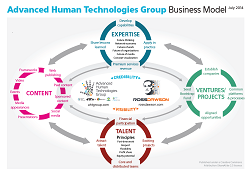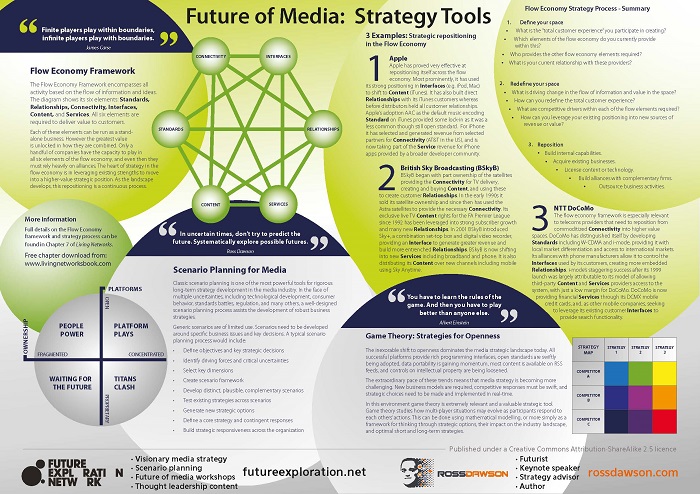Keynote Speaker
Keynote Speaker
Books
In the media
Business Model
Selection of Ross Dawson Frameworks
Future of Media: Strategy Tools
Click on the image to see full-size pdf
Flow Economy Framework
The Flow Economy Framework encompasses all activity based on the flow of information and ideas. The diagram shows its six elements: Standards, Relationships, Connectivity, Interfaces, Content, and Services. All six elements are required to deliver value to customers.
Each of these elements can be run as a standalone business. However the greatest value is unlocked in how they are combined. Only a handful of companies have the capacity to play in all six elements of the flow economy, and even then they must rely heavily on alliances. The heart of strategy in the flow economy is in leveraging existing strengths to move into a higher-value strategic position. As the landscape develops, this repositioning is a continuous process.
3 Examples: Strategic repositioning in the Flow Economy
1. Apple
Apple has proved very effective at repositioning itself across the flow economy. Most prominently, it has used its strong positioning in Interfaces (e.g. iPod, Mac) to shift to Content (iTunes). It has also built direct Relationships with its iTunes customers whereas before distributors held all customer relationships. Apple’s adoption AAC as the default music encoding Standard on iTunes provided some lock-in as it was a less common though still open standard. For iPhone it has selected and generated revenue from selected partners for Connectivity (AT&T in the US), and is now taking part of the Service revenue for iPhone apps provided by a broader developer community.
2. British Sky Broadcasting (BSkyB)
BSkyB began with part ownership of the satellites providing the Connectivity for TV delivery, creating and buying Content, and using these to create customer Relationships. In the early 1990s it sold its satellite ownership and since then has used the Astra satellites to provide the necessary Connectivity. Its exclusive live TV Content rights for the FA Premier League since 1992 has been leveraged into strong subscriber growth and many new Relationships. In 2001 BSkyB introduced Sky+, a combination set-top box and digital video recorder, providing an Interface to generate greater revenue and build more entrenched Relationships. BSkyB is now shifting into new Services including broadband and phone. It is also distributing its Content over new channels including mobile using Sky Anytime.
3. NTT DoCoMo
The flow economy framework is especially relevant to telecoms providers that need to reposition from commoditized Connectivity into higher value spaces. DoCoMo has distinguished itself by developing Standards including W-CDMA and i-mode, providing it with local market differentiation and access to international markets. Its alliances with phone manufacturers allow it to control the Interfaces used by its customers, creating more embedded Relationships. i-mode’s staggering success after its 1999 launch was largely attributable to its model of allowing third-party Content and Services providers access to the system, with just a low margin for DoCoMo. DoCoMo is now providing financial Services through its DCMX mobile credit cards, and, as other mobile companies, seeking to leverage its existing customer Interfaces to provide search functionality.
Flow Economy Strategy Process – Summary
1. Define your space
– What is the “total customer experience” you participate in creating?
– Which elements of the flow economy do you currently provide within this?
– Who provides the other flow economy elements required?
– What is your current relationship with these providers?
2. Redefine your space
– is driving change in the flow of information and value in the space?
– How can you redefine the total customer experience?
– What are competitive drivers within each of the flow elements required?
– How can you leverage your existing positioning into new sources of
3. Reposition
– Build internal capabilities.
– Acquire existing businesses.
– License content or technology.
– Build alliances with complementary firms.
– Outsource business activities.
Scenario Planning for Media
Classic scenario planning is one of the most powerful tools for rigorous long-term strategy development in the media industry. In the face of multiple uncertainties, including technological development, consumer
behavior, standards battles, regulation, and many others, a well-designed scenario planning process assists the development of robust business strategies.
Generic scenarios are of limited use. Scenarios need to be developed around specific business issues and key decisions. A typical scenario planning process would include:
– Define objectives and key strategic decisions
– Identify driving forces and critical uncertainties
– Select key dimensions
– Create scenario framework
– Develop distinct, plausible, complementary scenarios
– Test existing strategies across scenarios
– Generate new strategic options
– Define a core strategy and contingent responses
– Build strategic responsiveness across the organization
Game Theory: Strategies for openness
The inexorable shift to openness dominates the media strategic landscape today. All successful platforms provide rich programming interfaces, open standards are swiftly being adopted, data portability is gaining momentum, most content is available on RSS feeds, and controls on intellectual property are being loosened.
The extraordinary pace of these trends means that media strategy is becoming more challenging. New business models are required, competitive responses must be swift, and strategic choices need to be made and implemented in real-time.
In this environment game theory is extremely relevant and a valuable strategic tool. Game theory studies how multi-player situations may evolve as participants respond to each others’ actions. This can be done using mathematical modelling, or more simply as a framework for thinking through strategic options, their impact on the industry landscape, and optimal short and long-term strategies.





































